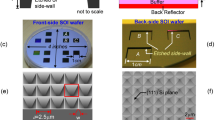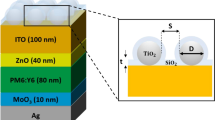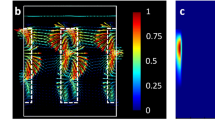Abstract
The enhancement of light absorption in absorber layers is crucial in a number of applications, including photovoltaics1 and thermoelectrics. The efficient use of natural resources and physical constraints such as limited charge extraction in photovoltaic devices require thin but efficient absorbers. Among the many different strategies used2,3,4,5,6,7, light diffraction8 and light localization9,10 at randomly nanotextured interfaces have been proposed to improve absorption. Although already exploited in commercial devices, the enhancement mechanism for devices with nanotextured interfaces is still subject to debate. Using coherent two-dimensional nanoscopy and coherent light scattering, we demonstrate the existence of localized photonic states in nanotextured amorphous silicon layers as used in commercial thin-film solar cells. Resonant absorption in these states accounts for the enhanced absorption in the long-wavelength cutoff region. Our observations establish that Anderson localization—that is, strong localization—is a highly efficient resonant absorption enhancement mechanism offering interesting opportunities for the design of efficient future absorber layers.
This is a preview of subscription content, access via your institution
Access options
Subscribe to this journal
Receive 12 print issues and online access
$209.00 per year
only $17.42 per issue
Buy this article
- Purchase on Springer Link
- Instant access to full article PDF
Prices may be subject to local taxes which are calculated during checkout



Similar content being viewed by others
References
Polman, A. & Atwater, H. A. Photonic design principles for ultrahigh-efficiency photovoltaics. Nature Mater. 11, 174–177 (2012).
Zhao, J. & Green, M. A. Optimized antireflection coatings for high-efficiency silicon solar cells. IEEE Trans. Electron Devices 38, 1925–1934 (1991).
Ferry, V. E. et al. Light trapping in ultrathin plasmonic solar cells. Opt. Express 18, A237 (2010).
Lükermann, F., Heinzmann, U. & Stiebig, H. Plasmon enhanced resonant defect absorption in thin a-Si:H n–i–p devices. Appl. Phys. Lett. 100, 253907 (2012).
Bermel, P., Luo, C., Zeng, L., Kimerling, L. C. & Joannopoulos, J. D. Improving thin-film crystalline silicon solar cell efficiencies with photonic crystals. Opt. Express 15, 16986–17000 (2007).
Tobías, I., Luque, A. & Martí, A. Light intensity enhancement by diffracting structures in solar cells. J. Appl. Phys. 4, 034502 (2008).
Cai, M., Painter, O. & Vahala, K. Observation of critical coupling in a fiber taper to a silica-microsphere whispering-gallery mode system. Phys. Rev. Lett. 85, 74–77 (2000).
Müller, J., Rech, B., Springer, J. & Vanecek, M. TCO and light trapping in silicon thin film solar cells. Sol. Energy 77, 917–930 (2004).
Riboli, F. et al. Anderson localization of near-visible light in two dimensions. Opt. Lett. 36, 127–129 (2011).
Vynck, K., Burresi, M., Riboli, F. & Wiersma, D. S. Photon management in two-dimensional disordered media. Nature Mater. 11, 1017–1022 (2012).
Yablonovitch, E. & Cody, G. D. Intensity enhancement in textured optical sheets for solar cells. IEEE Trans. Electron Devices 29, 300–305 (1982).
Yu, Z., Raman, A. & Fan, S. Fundamental limit of nanophotonic light trapping in solar cells. Proc. Natl Acad. Sci. USA 107, 17491–17496 (2010).
Basu Mallick, S., Sergeant, N. P., Agrawal, M., Lee, J.-Y. & Peumans, P. Coherent light trapping in thin-film photovoltaics. Mater. Res. Soc. Bull. 36, 453–460 (2011).
Anderson, P. W. Absence of diffusion in certain random lattices. Phys. Rev. 109, 1492–1505 (1958).
Lagendijk, A., van Tiggelen, B. & Wiersma, D. S. Fifty years of Anderson localization. Phys. Today 62 (8), 24–29 (2009).
Wiersma, D. S. Disordered photonics. Nature Photon. 7, 188–196 (2013).
Sapienza, L. et al. Cavity quantum electrodynamics with Anderson-localized modes. Science 327, 1352–1355 (2010).
Hewageegana, P. & Apalkov, V. Second harmonic generation in disordered media: random resonators. Phys. Rev. B 77, 075132 (2008).
Mascheck, M. et al. Observing the localization of light in space and time by ultrafast second-harmonic microscopy. Nature Photon. 6, 293–298 (2012).
Aeschlimann, M. et al. Coherent two-dimensional nanoscopy. Science 333, 1723–1726 (2011).
Schmidt, O. et al. Time-resolved two photon photoemission electron microscopy. Appl. Phys. B 74, 223–227 (2002).
Tian, P., Keusters, D., Suzaki, Y. & Warren, W. S. Femtosecond phase-coherent two-dimensional spectroscopy. Science 300, 1553–1555 (2003).
Lipovšek, B., Krč, J., Isabella, O., Zeman, M. & Topič, M. Analysis of thin-film silicon solar cells with white paint back reflectors. Phys. Status Solidi C 7, 1041–1044 (2010).
Lepetit, L., Chériaux, G. & Joffre, M. Linear techniques of phase measurement by femtosecond spectral interferometry for applications in spectroscopy. J. Opt. Soc. Am. B 12, 2467 (1995).
Farkas, G., Toth, C. & Kohazikis, A. Above-threshold multiphoton photoelectric effect of a gold surface. Opt. Eng. 32, 2476–2480 (1993).
Merschdorf, M., Pfeiffer, W., Thon, A., Voll, S. & Gerber, G. Photoemission from multiply excited surface plasmons in Ag nanoparticles. Appl. Phys. A 71, 547–552 (2000).
Krüger, M., Schenk, M. & Hommelhoff, P. Attosecond control of electrons emitted from a nanoscale metal tip. Nature 475, 78–81 (2011).
Sánchez-Gil, J., Freilikher, V., Maradudin, A. & Yurkevich, I. Reflection and transmission of waves in surface-disordered waveguides. Phys. Rev. B 59, 5915–5925 (1999).
Seal, K. et al. Coexistence of localized and delocalized surface plasmon modes in percolating metal films. Phys. Rev. Lett. 97, 206103 (2006).
Shah, A. V. et al. Thin-film silicon solar cell technology. Prog. Photovolt. Res. Appl. 12, 113–142 (2004).
Lee, P. A. & Ramakrishnan, T. V. Disordered electronic systems. Rev. Mod. Phys. 57, 287–337 (1985).
Weaver, R. L. Anderson localization of ultrasound. Wave Motion 12, 129–142 (1990).
Laurent, D., Legrand, O., Sebbah, P., Vanneste, C. & Mortessagne, F. Localized modes in a finite-size open disordered microwave cavity. Phys. Rev. Lett. 99, 253902 (2007).
Rockstuhl, C., Lederer, F., Bittkau, K. & Carius, R. Light localization at randomly textured surfaces for solar-cell applications. Appl. Phys. Lett. 91, 171104 (2007).
Riboli, F. et al. Engineering of light confinement in strongly scattering disordered media. Nature Mater. 13, 720–725 (2014).
Bliokh, K., Bliokh, Y., Freilikher, V., Savel'ev, S. & Nori, F. Colloquium. Unusual resonators: plasmonics, metamaterials, and random media. Rev. Mod. Phys. 80, 1201–1213 (2008).
Acknowledgements
The authors acknowledge Malibu GmbH & Co KG for sample preparation and characterization and thank A. Steinbacher for help regarding the measurement and analysis software. This work was supported by the German Science Foundation (DFG) within the SPP 1391 (M.A., T.B. and W.P.), the Federal Ministry for Economic Affairs and Energy within the Globe-Si cooperative project (no. 0325446), the GSC 266 (P.T.) and by the Bavarian Collaborative Research Network ‘Solar Technologies Go Hybrid (SolTech)’ (T.B.).
Author information
Authors and Affiliations
Contributions
The author list is in alphabetical order. M.A., T.B. and W.P. initiated and supervised the work. H.S. coordinated sample preparation at Malibu GmbH & Co KG. U.H. and H.S. supervised the sample design and characterization performed by F.L. D.D. performed and evaluated the backscattering experiments. M.H., C.K., P.M., M.P., C.Sc., C.St. and P.T. performed the coherent 2D nanoscopy. C.St. and W.P. developed the data analysis procedure for evaluating the 2D spectra based on the thermionic emission model. All authors contributed to manuscript preparation.
Corresponding author
Ethics declarations
Competing interests
The authors declare no competing financial interests.
Supplementary information
Supplementary information
Supplementary information (PDF 3884 kb)
Rights and permissions
About this article
Cite this article
Aeschlimann, M., Brixner, T., Differt, D. et al. Perfect absorption in nanotextured thin films via Anderson-localized photon modes. Nature Photon 9, 663–668 (2015). https://doi.org/10.1038/nphoton.2015.159
Received:
Accepted:
Published:
Issue Date:
DOI: https://doi.org/10.1038/nphoton.2015.159
This article is cited by
-
High-resolution two-dimensional electronic spectroscopy reveals the homogeneous line profile of chromophores solvated in nanoclusters
Nature Communications (2022)
-
Nonlinear plasmon-exciton coupling enhances sum-frequency generation from a hybrid metal/semiconductor nanostructure
Nature Communications (2020)
-
Indirect optical crosstalk reduction by highly-doped backside layer in single-photon avalanche diode arrays
Optical and Quantum Electronics (2018)
-
Long-lived electron emission reveals localized plasmon modes in disordered nanosponge antennas
Light: Science & Applications (2017)
-
Design of Non-Deterministic Quasi-random Nanophotonic Structures Using Fourier Space Representations
Scientific Reports (2017)



